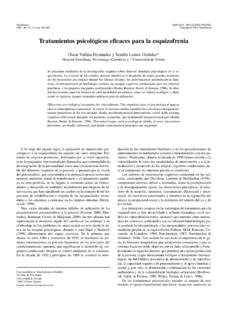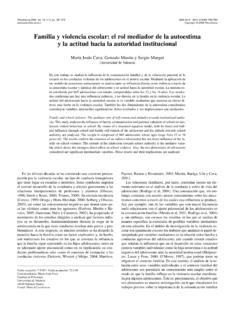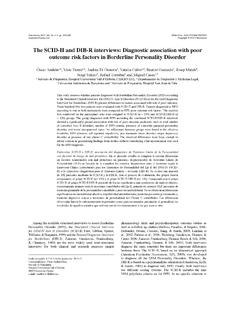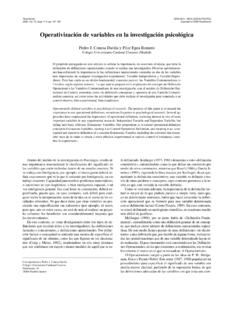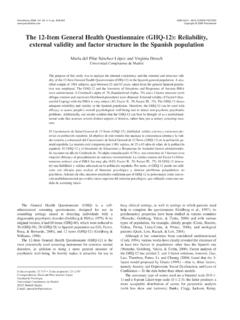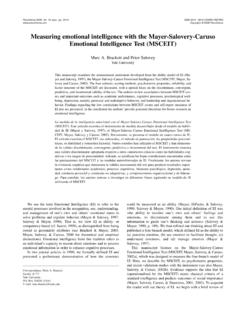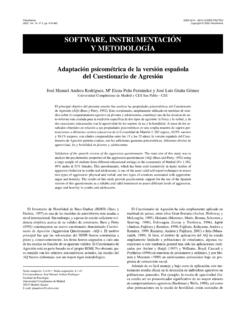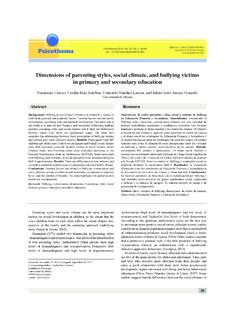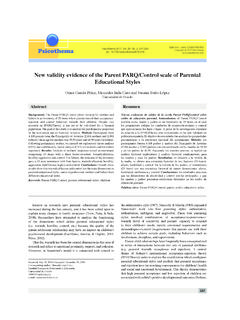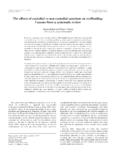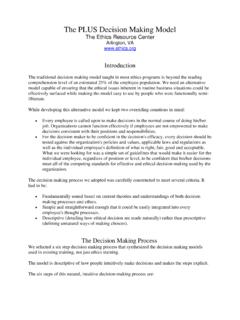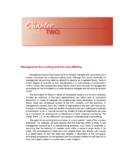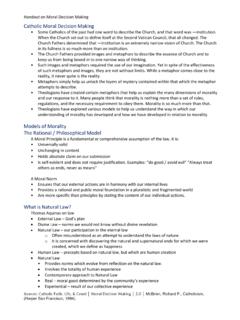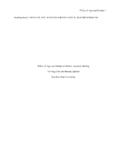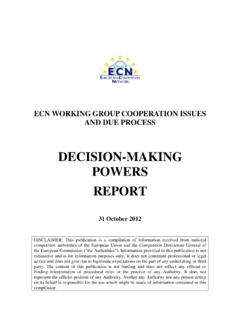Transcription of Decision-making patterns, conflict sytles, and self …
1 A Decisional conflict ModelIn 1977, Irving Janis and Leon Mann proposed a descriptivemodel of the decision making process, in which they advanced theidea that the need to make a decision involves a conflict which en-genders a certain degree of stress, the excess or absence of whichis in turn a major determinant of the subject s failure to make a go-od decision , since it is associated with unproductive informationsearch, assessment and decision making patterns . This stress stemsfrom two concerns: on the one hand, a worry about the objectivepersonal and material losses that may result from the chosen alter-native; and on the other, a worry about the subjective losses thatmay lower self-esteem (Janis and Mann, 1979). It is, in short, acognitive assessment model very similar in some aspects to othercognitive models such as those developed by Bandura (1977) orLazarus and Folkman (1984).
2 All these models involve a doubleassessment: (a) assessment of the demands of a specific environ-ment, and (b) self-assessment of the personal resources availableto respond to these demands. In Janis and Mann s model , the mostdecisive resource affecting a decision making process is the timeavailable. In this model , the presence or absence of three antecedent con-ditions determines which decisional conflict pattern the subjectchooses to follow: (1) awareness of a serious risk if nothing is do-ne, (2) hope of finding a better alternative and (3) belief that thereis enough time to learn about and assess the situation and choosethe best alternative. The five resulting patterns are: unconflictedadherence, unconflicted change, defensive avoidance, hypervigi-lance and vigilance.
3 According to the definition offered by the mo-del, only the last of these, vigilance, is adaptive, being characteri-sed by the systematic search for information, careful considerationof all viable alternatives and the unhurried, non-impulsive makingof the final decision . The model proposed by Janis and Mann (1977) has been wi-dely acclaimed among researchers working in the field of decisionmaking. Stress theorists have deemed it an interesting contribution(see Lazarus and Folkman, 1986) and it has inspired research intodecision making under threat-engendered stress (Keinan, 1987)and suggested new frameworks for decision making in complexsituations such as air traffic control (O Hare, 1992). Equally, somestudies have emphasised the role assigned to stress in this modelas a factor which distorts information and triggers pre-program-med, stereotyped responses, which do little towards encouraging aconstructive method of handling conflicts (Folger, Poole, and Stut-man; 1997).
4 In short, the procedures recommended in Janis andDecision- making patterns , conflict sytles, and self-esteemRam n Alzate S ez de Heredia, Francisco Laca Arocena and Jos Valencia G rateUniversidad del Pa s VascoIn light of the increasing amount of literature available in English regarding personal decision -makingstyles or patterns , we have adapted the Melbourne Leon Mann (1997) to our particular pur-poses. This questionnaire is itself a revised version of the Flinders (1982), both instrumentsbeing based on the decisional conflict model proposed by Irving Janis and Leon Mann in 1977. Twostudies were carried out with a threefold objective: (1) to validate our adaptation of Mann s instrument(1982, 1997) from a psychometrical point of view; (2) to analyse, within our context, the similaritiesand differences between our own university students and those from other cultures as regards decisionpatterns and Decision-making self-esteem; and finally (3), to study the possible relationship betweendecision patterns and conflict coping styles .
5 Finally, the paper examines the theoretical implications ofthe aforementioned de decisi n, estilos de afrontamiento del conflicto y el creciente inter s enla literatura en lengua inglesa respecto a patrones o estilos personales en la toma de decisiones, el pre-sente art culo adapta el Melbourne del profesor Leon Mann (1997) a nuestro contexto. Estecuestionario es, a su vez, una revisi n del Flinders (Mann, 1982), estando ambos instrumen-tos soportados en el modelo de conflicto de decisi n propuesto en 1977 por Irving Janis y Leon llevan a cabo dos estudios con un triple objetivo: (1) validar psicometricamente nuestra adaptaci ndel cuestionario de Mann; (2) analizar en nuestro contexto similitudes y diferencias entre nuestros uni-versitarios y los de otras culturas respecto al uso de patrones de decisi n y autoestima como tomado-res de decisiones; y finalmente, (3) estudiar la posible relaci n entre patrones de decisi n y estilos deafrontamiento del conflicto.
6 Por ltimo, el art culo examina algunas implicaciones te ricas de los re-sultados recepci n: 10-2-03 Fecha aceptaci n: 30-5-03 Correspondencia: Ram n Alzate S ez de HerediaFacultad de Psicolog aUniversidad del Pa s Vasco20080 San Sebasti n (Spain)E-mail: 2004. Vol. 16, n 1 pp. 110-116 ISSN 0214 - 9915 CODEN 2004 PsicothemaMann s model for making balanced decisions are seen by Weitz-man and Weitzman (2000) as a means of counteracting the ego-centric biases which conflicts so often (1982)In order to assess the patterns proposed by the aforementionedmodel, in 1982 Leon Mann presented the Flinders decision Ma-king Questionnaire, Flinders. (31 items), consisting of avigilance scale (6 items), a hypervigilance scale (5 items) and adefensive avoidance scale (5 items); as well as another three sca-les measuring different expressions of defensive avoidance, na-mely procastination or postponement (5 items), buck-passing (5items) and rationalisation (5 items).
7 Psychiatric research has alsoused the Flindersscales, linking scores on the hypervigilance anddefensive avoidance scales to the severity of some disturbances(Redford, Mann, and Kalucy, 1986). Similarly, research has alsobeen carried out into the relationship between the scores on theprocrastination scale and the tendency to ruminate on past or futu-re states rather than focus on immediate plans of action (Kuhl,1985). On a slightly different note, the Flinders alsobeen used as a means of assessing the tendency to use different de-cision making styles during the course of academic life (Beswick,Rothblum, and Mann, 1988). In this sense, modest, albeit signifi-cant correlations have been found between vigilance patterns infirst-year university students and the academic performance of thesame students during their second year.
8 A significant correlationhas also been found between scores on the defensive avoidanceand hypervigilance scales (the two typically non-vigilant copingpatterns) and poor academic results (Burnett, Mann, and Beswick,1989). Furthermore, a modest relationship has been found betwe-en self-esteem as a decision -maker and the patterns assessed bythe Flinders (Burnett, 1991). Research evidence linkingdecision making with self-esteem, although still fairly scarce, ne-vertheless suggests that a subject s positive image of him/herselfas a decision -maker is associated with the use of productive deci-sion making criteria, while a negative self image is linked to theuse of non-productive criteria (Burnett, 1991). Empirical evidencehas been found linking the vigilance pattern with self-satisfactionlevels in university students (Fletcher and Wearing, 1992), and de-cision patterns have also been studied in connection with women sdecisions regarding whether or not to undergo cancer screeningtests (White, Wearing and Hill, 1994).
9 In our country, Barbero, etal. (1993) presented an adaptation of the Flinders whichwas administered to 605 subjects of both sexes aged between 18and 45. This adaptation constituted the first Spanish language versionof Mann s questionnaire. Using exploratory factorial analysis, theresearchers identified five factors in their sample, several of whichthey organised somewhat differently from the original patterns de-fined by Mann in 1982. Melbourne D. M. Q. (1997)Using a strategy based on the data obtained, Mann, Burnett,Radford and Ford (1997) subjected the Flinders a num-ber of structural equation analyses with the aim of reducing thenumber of items (31) comprising the instrument. The resulting 22items became the Melbourne authors tested three ba-sic models: a first, two-factor model , comprising vigilance as onefactor and the remaining coping patterns as the other; a second, th-ree-factor model , comprising vigilance as the first factor, hypervi-gilance as the second factor and the remaining defensive avoidan-ce patterns as the third factor; and finally, a third model compri-sing six factors grouped as follows: vigilance, hypervigilance,buck-passing, defensive avoidance, postponement or procrastina-tion and rationalisation.
10 When all three models were compared, the authors found thatthe goodness-of-fit indices were higher in model 3, and conse-quently adopted this model . A more focused analysis of this thirdmodel led them to reduce the number of factors from six to , they eliminated from the Flindersquestionnaire thoseitems whose squared multiple correlation was significantly lessthan And secondly, in light of the high correlation betweenbuck-passing and defensive avoidance, they merged these two fac-tors to create a new factor called buck-passing. One item from thedefensive avoidance scale (item 23) loaded highly with hyper-vigilance items (lambda ) and was therefore added to that sca-le. Furthermore, item 10 of the defensive avoidance factor was al-so eliminated, since it did not belong with the hypervigilance sca-le loaded with the other avoidance items.
